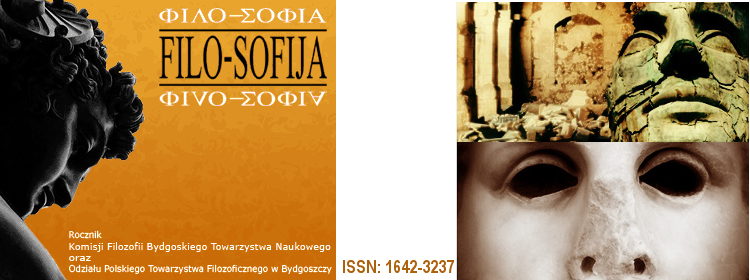Mam poprzednika, i to jakiego! OkolicznoŇõci powstawania NietzscheaŇĄskiego Zaratustry
Abstract
Author: ŇĽelazna Jolanta Title: ‚ÄěI‚ÄôVE GOT A PREDECESSOR, AND WHAT A FINE ONE TOO!‚ÄĚ CIRCUMSTANCES OF THE CREATION OF NIETZSCHE‚ÄôS ZARATHUSTRA (‚ÄěMam poprzednika, i to jakiego!‚ÄĚ OkolicznoŇõci powstawania NietzscheaŇĄskiego Zaratustry) Source: Filo-Sofija year: 2005, vol:.5, number: 2005/1, pages: 173-187 Keywords: SPINOZA, NIETZSCHE, JUNG‚ÄôS THEORY OF ARCHETYPES Discipline: PHILOSOPHY Language: POLISH Document type: ARTICLE Publication order reference (Primary author‚Äôs office address):
E-mail:
www:
Abstract The name of Spinoza appears in the notes of F. Nietzsche from the beginning of the eighties. Basing on information contained in K. Fisher‚Äôs History of Philosophy he hails the sage of Haga as his predecessor. In the course of next few years the greatest works of Nietzsche are written and his professional, personal and health matters become very complicated. At the end of his life embittered, lonely and deeply misunderstood Nietzsche pens remarks concerning Spinoza‚Äôs writings once again ‚Äď this time drastically different in style and the judgement of their worthiness. As both of the philosophers use the term of ‚Äėpower‚Äô, both reject personalised God and propose the reversion of the hierarchy of the moral values, many researchers were inspired by Nietzsche‚Äôs notes to investigate the connections of the two philosophies. However, is the connection real, or is it but an illusion, a delusion of a link caused by the use of similar devices and terms in different contexts? How did such a radical change in Nietzsche‚Äôs views come to pass ‚Äď a change of views not only of Spinoza‚Äôs philosophy, but of Schopenhauer and Wagner‚Äôs musical work as well? The answers to those questions may be sought with use of Jung‚Äôs theory of archetypes, as an example. In reference to Nietzsche‚Äôs biography it shows one of the possible interpretations of his approach to the persons mentioned.
E-mail:
www:
Abstract The name of Spinoza appears in the notes of F. Nietzsche from the beginning of the eighties. Basing on information contained in K. Fisher‚Äôs History of Philosophy he hails the sage of Haga as his predecessor. In the course of next few years the greatest works of Nietzsche are written and his professional, personal and health matters become very complicated. At the end of his life embittered, lonely and deeply misunderstood Nietzsche pens remarks concerning Spinoza‚Äôs writings once again ‚Äď this time drastically different in style and the judgement of their worthiness. As both of the philosophers use the term of ‚Äėpower‚Äô, both reject personalised God and propose the reversion of the hierarchy of the moral values, many researchers were inspired by Nietzsche‚Äôs notes to investigate the connections of the two philosophies. However, is the connection real, or is it but an illusion, a delusion of a link caused by the use of similar devices and terms in different contexts? How did such a radical change in Nietzsche‚Äôs views come to pass ‚Äď a change of views not only of Spinoza‚Äôs philosophy, but of Schopenhauer and Wagner‚Äôs musical work as well? The answers to those questions may be sought with use of Jung‚Äôs theory of archetypes, as an example. In reference to Nietzsche‚Äôs biography it shows one of the possible interpretations of his approach to the persons mentioned.
PeŇāny tekst:
PDFAdministracja Cytowania | Strony czasopism
